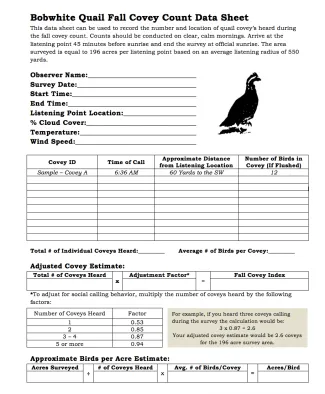
By Kyle Johnson, Quail Habitat Biologist
Many quail hunters head to the field on opening day of the season knowing they have quail, but uncertain how many coveys may actually be present. In addition, considerable time can be spent trying to decide whether to hunt this location or if a different one may be better. Completing fall covey count surveys can be a valuable tool to help resolve these difficult dilemmas that quail hunters face each year.
Coveys of Northern bobwhites can begin to form as early as August. By September, they start to communicate through early morning "wake-up" calls. The seasonal calling peaks mid-October and is well-timed for quail hunters, as it provides the perfect opportunity to collect valuable data on a piece of property, including an estimate of the number of coveys that might be present.
The fall whistle of the bobwhite isn't the breeding "bob-white" that is readily heard during the spring and summer months, but a "koi-lee" whistle which is brief, averaging 30 seconds or less. Depending on the number of coveys that may be present, the calling lasts only a few minutes and generally begins about 25 minutes before sunrise. Clear mornings with light breezes are the best time to hear calls, but passing cold fronts and a decreasing barometric pressure can reduce or even eliminate calling altogether. Flushing one or more coveys after the calling ends is a perfect way to determine covey size and get a firsthand look at important roosting habitat on a given property.
Completing fall covey count surveys is easy and can be broken down into three steps:
Step 1 is to establish listening locations at least 1,100 yards from each other. This ensures coveys are not counted more than once if multiple people are listening from different locations during the same morning. Printing an aerial map of the property and marking the listening points helps to organize each point correctly.
Step 2 is to arrive at the listening point 45 minutes before sunrise and listen for each covey's call until sunrise. Marking the time of the call and the approximate location of each calling covey on a map helps provide a clearer picture of the number of coveys which may be present. Being conservative in the number of individual coveys is best.
Step 3 is to analyze the results. By entering the data into the calculations on the Fall Covey Count Data Sheet (see below), an adjusted fall covey index can be determined for each listening point. In addition, if a covey (or more) is flushed, the number of birds per acre can be estimated. As with all surveys, accuracy is improved when multiple points are surveyed per property and/or multiple counts are completed at each listening station. For properties less than 200 acres, only one listening point would be needed to estimate the number of quail present.
Although free time is not always easy to find within our busy schedules these days, completing fall covey counts now can help save time during the hunting season when deciding which areas to hunt and which to avoid. In addition, completing the counts annually can show population trends for a property and help prioritize management decisions for quail.
The Oklahoma Department of Wildlife Conservation conducts roadside surveys on a statewide level in August and October each year. While the October surveys have not occurred yet, here is a link to this year's August survey: www.wildlifedepartment.com/hunting/species/quail/quail-roadside-survey
If you have questions about improving habitat for quail, contact Kyle Johnson, quail habitat biologist, at (405) 684-1929. For more information, check out the Oklahoma Quail Habitat Guide issue of Outdoor Oklahoma magazine (May/June 2013) as well as the Wildlife Department website at wildlifedepartment.com.